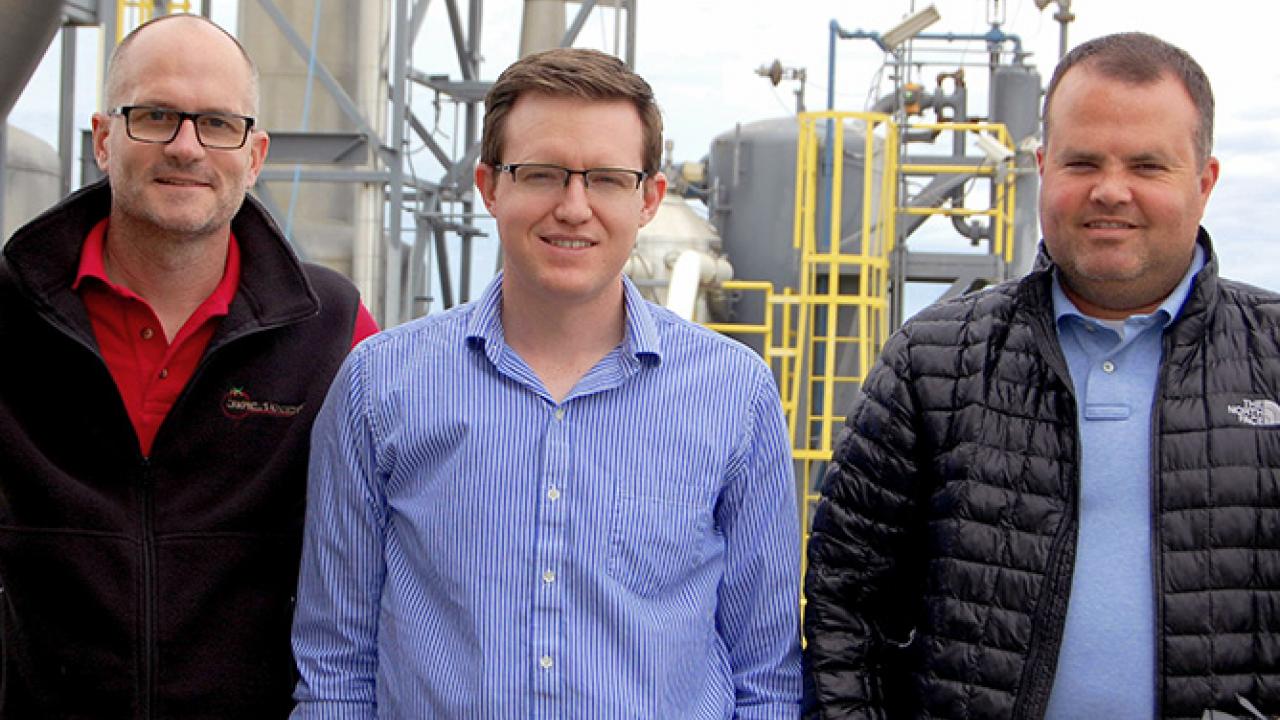
Working Together To Manage Drought
CA&ES researchers are developing and improving technology to help manage California's scarce water resources.
In fields, orchards, wineries, and food-processing plants across California, the agriculture industry is coping with the fourth straight year of drought. Many people haven’t fully recovered from last year’s drought, which was responsible for the greatest water loss ever seen in California agriculture. Some 17,000 agricultural jobs were lost and 425,000 acres of farmland were laid fallow.
But California’s agriculture industry is not in it alone. Working with growers, industry, and agencies throughout the state, CA&ES researchers are developing and improving technology to help California manage its vital, scarce water resources.
Optimizing irrigation
Are there practical ways growers can stretch water without reducing crop production, quality, and yield? Yes, researchers say, and the key is optimizing irrigation — watering not too much and not too little. For decades, a UC Davis technological advance has helped growers find that fine line: pressure chambers.
Pressure chambers are tools that measure how hard a plant is working to pull moisture from the soil, providing an accurate read of a crop’s changing water needs. Many growers irrigate when it’s hot outside and the soil is dry, which can lead to overwatering.
“Just because the soil is dry, doesn’t mean plants are suffering,” said plant physiology professor Ken Shackel, whose research led to routine use of pressure chambers on orchard crops and vineyards in the 1990s.
Dry soil and arid atmosphere can cause water stress, but those aren’t the only causes. And some crops can manage fine in drier conditions, based on a variety of factors such as root health.
“That’s why we like to ask the plant directly,” Shackel said.
As the drought wears on, more growers are making the $1,200 to $3,000 investment, and they’re glad they did.
“Pressure chambers are a fantastic tool for making sure you’re watering your trees only when they need it,” said Jerry Sneed, field representative for Crain Ranch, a walnut producing and processing operation in Los Molinas, California. “I have total faith in them. They’ve never steered us wrong.”
Producing wine with less water
A typical winery uses four to six gallons of water after the grapes are harvested to produce one gallon of wine, with most of that water used to wash equipment. Viticulture and enology professors Roger Boulton and David Block are developing self-cleaning fermentors capable of recycling 90 percent of that water. The goal: affordable technology that uses one gallon of water to produce one gallon of wine.
Winemakers currently remove sticky, fermented, grape residue from tanks with water and elbow grease. Clean-in-place technology replaces hand cleaning with an automated system that sprays tanks with a hot, caustic solution such as sodium or potassium hydroxide.
“The dairy industry has used clean-in-place technology since the 1960s and the pharmaceutical industry since the 1990s,” said Block, who helped the pharmaceutical industry manage clean-in-place technology before coming to UC Davis in 2008. “It’s a little different with dairy and pharmaceuticals, where poor sanitation can kill you, but the concept is similar.”
There’s still work to be done to ensure the technology is affordable on a commercial scale, but wineries are already interested.
“Clean-in-place technology is very attractive to us,” said Ashley Heisey, director of winemaking at Long Meadow Ranch in Rutherford, Calif., and a UC Davis viticulture and enology graduate (M.S. ’91). “Water is such a critical issue. Long Meadow Ranch owners Ted, Chris, and Laddie Hall built our facilities with great concern for the environment, and thanks to UC Davis, we can take it one step further.”
Fine-tuning food processing
New technology can save water. But sometimes, all it takes is fine-tuning what already exists. New research from food science and technology professor Chris Simmons helps food processors improve equipment efficiency, which saves water, energy, and money.
“We analyze a processing plant’s entire system — its water supply and where and how it’s being used,” said Simmons. “We look at every pipe, pump, and procedure and tell companies what modifications would have the biggest impact on water and energy savings.”
Simmons and his team visited the Campbell’s Soup tomato processing plant in Dixon, Calif., for example, and found ways to reduce water use by 20 percent and energy use by 3 percent.
“That represents a significant monetary savings, too,” said Dr. Daniel Sonke, manager of agriculture sustainability programs for Campbell Soup Company. “Dr. Simmons and his team gave us a new way to look at how we use water and energy. Before, we might not know a pump is deteriorating until it gives out, for example, but they helped us quantify how much replacing or refurbishing it could increase efficiency.”
Simmons’ team has visited several food processing plants in California, and is happy to work with others.
“Sustainability is the key to keeping California’s food processing industry — and agriculture in general — viable and strong,” Simmons said.
- Related content
- Outlook Magazine Articles